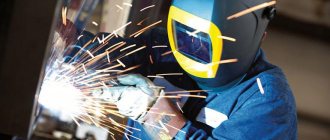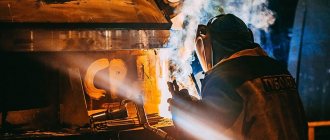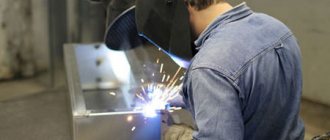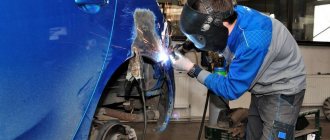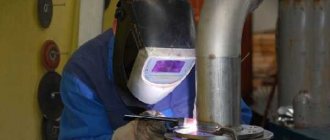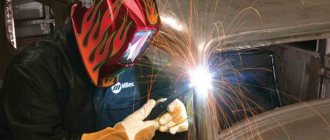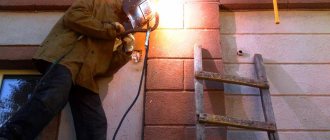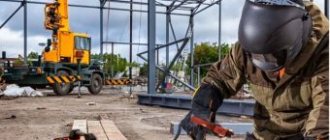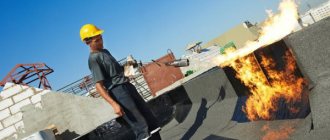History of appearance
At the end of the 19th century, the American scientist Charles Coffin was the first to use inert gases for welding metal products. His research was based on the experiments of Russian physicists Vasily Petrov and Nikolai Slavyanov, who discovered the arc method of welding parts. The new technology did not allow welding workpieces made of aluminum and magnesium, which was due to a change in the degree of oxidation of the materials when interacting with air.
In the 30s XX century TIG welding technology was improved by American scientists Russell Meredith and Northrop Aycraft. In 1941, inert gases began to be actively used for welding magnesium on direct current. A few years later, specialists at Northrop Corporation began using TIG technology to join aluminum, magnesium and nickel parts. This contributed to the development of the aviation industry and rocket science.
Why is it worth taking an argon training course?
Argon welding is a welding method in an inert gas environment, argon. Allows you to work efficiently and quickly with materials from the heavy category, the oxidation of which occurs at the slightest contact with air. A professional argon welder is a welder who is familiar with all the nuances and features of working with this technology and is capable of completing the task at the highest level. You can obtain this specialization by completing argon welding courses (qualification: welder of manual arc welding with a non-consumable electrode in shielding gas, 4-5 category).
The essence of the TIG welding process
Translated from English, the abbreviation TIG means “tungsten + inert gas” (Tungsten + Inert Gas). The operating principle of TIG welding is the burning of an electric arc in argon. This inert gas is heavier than air. It protects the materials being welded from exposure to oxygen. Argon prevents the oxidation of metals. The result is a neat and durable weld.
Electrodes for argon arc welding are made of tungsten. The melting point of this chemical element is 4000 °C. It can work with all types of steel. To weld a strong seam, you need to periodically sharpen the tungsten electrode. This procedure will increase the service life of the electrical conductor and reduce the risk of reducing its service life. The following values of electrode sharpening angles are distinguished:
- 10–20 °C: at low electric current.
- 20-30 °C: at average current values.
- 60-120 °C: with increased electric current.
If the sharpening angle is less than 20 °C, then the physical properties of the tungsten electrode will change. At high temperatures (above 90 °C), the stability of the electric arc during combustion decreases. Sharpening must be done along the surface of the electrical conductor so as not to deform it. Turning is carried out using grinders, wheels made of fine-grained abrasive materials and sandpaper. To ensure high sharpening accuracy, it is recommended to attach the electrode to the rod of a screwdriver or drill.
The sharpened electrical conductor is fixed to a conical tube located on the burner nozzle. Part of the electrode is covered with a case that prevents short circuits. For TIG welding it is necessary to use RGA-150 or RGA-440 torches. Their main parameters are specified in GOST 5.917-71.
GOST 5.917-71 Manual torches for argon-arc welding type RGA-150 and RGA-400
1 file(s) 287.76 KB
A torch with an electrical conductor is placed in a weld pool with an inert gas. As a result, the electrode is isolated from oxygen. The launch of argon is controlled using function buttons on the torch. When setting up the torch, it is recommended to increase the electrode extension. In this case, the electric arc will be able to weld hard-to-reach elements of metal workpieces.
In the process of argon arc welding with a consumable electrode, an electric arc is ignited. During its combustion, the edges of the welded parts melt. In weld pools without gas, the electronic arc will not burn stably. As a result, the porosity of the seam will increase, reducing its strength.
When TIG welding, it is not recommended to use non-consumable electrodes. In this case, the electric arc will not ignite when the tungsten conductor interacts with the metal surface. When igniting an arc with non-consumable electrodes, a weak spark is formed, which is due to the high degree of ionization of the inert gas.
If during TIG welding a gap is formed between the metals being welded, then filler wire must be used. This device will create a strong seam that is not subject to tears or breaks. The diameter of the wire depends on the width of the workpieces being welded and the shape of the seam.
To create strong metal joints using TIG technology, the following devices are used:
- The source of electric current is the power supply.
- Oscillator - a device for generating high-frequency current that ignites an electric arc.
- An inverter is a device that converts direct current into alternating current.
- Cylinders with inert gas.
- A gearbox is a device for converting transmitted power into useful work.
- Gas-burner.
- Connectors and fastening mechanisms.
Using this equipment you can weld products made of stainless steel, brass, copper and bronze.
To choose the right tools for TIG welding, you need to consider the following factors:
- power supply voltage;
- the presence of an option to change polarity;
- the ability to weld thick parts over a long period of time;
- the presence of a liquid cooling system designed to lower the burner temperature;
- the ability to adjust the operation of the inverter using the display;
- Ability to work on production lines.
The main apparatus for argon arc welding is a welding inverter. It is capable of converting direct current into alternating current by changing its frequency. The welding inverter has the following advantages:
- High efficiency and structural strength, which allows you to create high-quality seams in a short period of time.
- Autonomy of work. During operation, the welder can change the location of the inverter.
- Compactness. The device is small in size and weighs no more than 3 kg.
- High efficiency, which allows you to create a large number of seams with minimal resource costs.
- Low energy consumption, which allows you to save a lot of money.
- Low control complexity. The welder can regulate the smooth supply of current manually.
A welding inverter can be constructed at home using graphic diagrams. To do this, you need to purchase a set of hoses, an oscillator and a device for delaying the flow of electric current. Self-assembly of a welding inverter will save a large amount of money. To carry out installation work, a person must know the basics of mechanics and have experience working with circuit boards and small parts.
Training in argon welding of stainless steel
Stainless steel is currently very popular in human everyday life, and therefore often requires primary welding or secondary welding of the resulting defect.
Stainless steel has a number of features that affect the result and subtleties of its welding. For example, the thermal conductivity of stainless steel, reduced by 2 times, dictates the need to reduce the current during welding by 15-20%, and a high coefficient of linear expansion can lead to deformation of the product during or after welding.
When welding pipes, all the features that we talked about above are used, but the following rule must be followed: the parts of pipes welded together must be securely fixed and pressed against each other as much as possible.
If this is not done, then any (even microscopic) change in the position of one part relative to another will cause destruction of the welding seam, and, accordingly, the integrity of the part. They usually cook from right to left, and the burner should be located at an angle of 70-80 0.
We have introduced you to the basics of welding art, and practice will help you achieve mastery in it.
Application
TIG welding is actively used in industry due to the high combustion temperature of the electric arc. This technology allows you to weld parts made of carbon and stainless steel, cast iron, aluminum and other refractory metals. TIG technology has found application in the following areas:
- mechanical engineering;
- food industry;
- construction of buildings and infrastructure;
- construction of oil rigs and drilling structures;
- laying of pipelines;
- astronautics and rocket science;
- construction of airplanes, trains and ships.
TIG welding is used in domestic conditions. Using this technology, you can repair cracks in a car radiator, make kitchenware or metal towel rails.
Advantages and disadvantages
The following advantages of argon arc welding are highlighted:
- When welding metal, its surface does not deform, which is due to the narrow heating zone.
- The weld seam does not require cleaning.
- Environmental friendliness: TIG welding does not have a negative impact on the environment.
- Versatility: this method of welding metals can be used when processing parts of different thicknesses and shapes.
- Low complexity of the technological process. Welding products using TIG technology can be performed by welders who are not highly qualified.
- Argon does not allow the parts being welded to interact with oxygen, which increases the strength of the weld.
TIG welding has the following disadvantages:
- High cost of the equipment used.
- Low efficiency when welding products outdoors. To protect metals from oxygen, it is necessary to increase the supply of inert gas, which leads to excessive consumption of resources.
- To process hard-to-reach areas, it is necessary to further trim the electrode or increase its extension.
- When using the TIG Lift function during operation of welding inverters, marks may appear on the surface of the workpieces.
The main disadvantages of TIG welding depend on the welder’s professional skills and work experience.
The value of the profession of argon welder
The materials that this specialist has to work with are used in heavy industries such as mechanical engineering, shipbuilding and aircraft construction, as well as in car repair and other industries. The qualities that a specialist working with argon welding must have are, first of all, organization, accuracy, and responsibility. A prerequisite is the availability of relevant knowledge and work experience.
To receive a special category and permission to carry out work that involves argon welding, the student must take special courses that improve his qualifications. The training will provide an opportunity to gain knowledge about the chemical and physical properties of metals that you will encounter in your work. The program includes mandatory safety lectures that will help protect you from situations that are dangerous to life and health. Completion of studies is accompanied by an exam and receiving a rank.
For what reason is the profession of argon welder in such high demand today? Firstly, not everyone can receive a discharge. Secondly, the scope of specialization is becoming increasingly widespread. Therefore, argon specialists are needed not only in large enterprises, but also in small, narrowly focused organizations. We can say with confidence that an argon operator is a prestigious profession that can bring its owner a high income.
Welding power source
To supply electricity during the TIG welding process, the following types of power sources are used:
- Power supply for MMA welding. It has an external current-voltage characteristic that allows ignition of an electric arc.
- AC/DC power supply. It is equipped with functional buttons that allow you to adjust the shape of the seam. With this device you can weld with both alternating and direct current.
- PROTIG and MECHTIG installations. They are based on a DC inverter power supply. The welding process is controlled using a computer device.
It is necessary to select a power supply in accordance with the circuits of the welding inverter. Otherwise, the devices will not be able to connect to a single electrical network. It is important that inverters for TIG welding are equipped with moisture separators. They do not allow moisture to penetrate the argon environment. If liquid gets on the surface to be welded, many cracks will appear on the seam.
Argon arc welding, terms. How will this be correct...?
When working with technical literature, you can pay attention to the fact that the term itself - “argon arc welding” often has different forms of notation. The forms used are: “argon welding”, “argon-arc welding”, “argon-arc welding”. Sometimes serious debates flare up on this issue..... Our Russian language is great and powerful, therefore, without going deeply into its rules, I propose to pay more attention to the TIG welding process itself, and to define the concept use GOST 2601-84 “Welding of metals. Terms and definitions of basic concepts."
Welding materials used
TIG welding requires the following materials:
- protective gases;
- electrical conductors (electrodes);
- filler rods and wires.
Welding materials ensure stable combustion of the electric arc and obtain pore-free welds with high resistance to mechanical stress.
Shielding gases
Shielding gases for TIG welding affect metal transfer, shape and physical characteristics of the weld. They allow you to increase the speed and efficiency of welding. Argon is most often used as a shielding gas. It has low thermal conductivity and low ionization potential. When welding parts in an argon environment, the seam is deep and narrow.
Helium can also be used as a shielding gas for TIG welding. It conducts heat easily and has a high ionization potential. When welding products in a helium environment, the width of the seam increases. This inert gas ensures stable wetting of the workpieces being welded along the edges.
Electrodes
Electrodes for argon arc welding consist of durable tungsten, which is one of the most refractory chemical elements.
They improve the quality of the seam and heat up slightly when an electric arc burns. The following table shows the consumption of tungsten electrodes for argon arc welding of parts made of various materials: Electrode consumption
| Material to be welded | Surface thickness, mm | Diameter of electrical conductors, mm | Consumption per 100 m of seam, g | |
| For manual welding | During automatic welding | |||
| Stainless steels with high heat resistance | 1 | 1,5 | 8,3 | 3,9 |
| 2 | 2 | 23,4 | 10,9 | |
| 3 | 3 | 83,3 | 39 | |
| 4 | 4 | 132,2 | 125 | |
| 5 | 5 | 165 | 156 | |
| Magnesium and aluminum alloys | 2 | 2 | 23,4 | 10,9 |
| 4 | 3 | 83,3 | 39 | |
| 5 | 4 | 132,2 | 156 | |
| 7 | 5 | 165 | 156 | |
Tungsten electrodes for argon welding do not require the use of additives and various wires. To improve the technical characteristics of electrical conductors, it is necessary to pre-sharpen them. This procedure will ensure a stable arc while welding workpieces.
Text of the book “Welding: A Practical Guide for Electric and Gas Welders”
Evgeniy Maksimovich Kostenko
Welding work: A practical guide for electric and gas welders
Introduction
In the context of scientific and technological progress, the development of the areas of science, technology and production that define it is especially important. These may include welding and cutting of metals, which in many industries are one of the main factors determining the pace of technical progress and have a significant impact on the efficiency of social production. There is practically no branch of mechanical engineering, instrument making and construction in which welding and cutting of metals are not used.
The welded design of many types of metal structures has made it possible to most effectively use workpieces obtained by rolling, bending, stamping, casting and forging, as well as metals with different physical and chemical properties. Welded structures, compared to cast, forged, riveted, etc., are lighter and less labor-intensive. Using welding, permanent joints of almost all metals and alloys of varying thickness are obtained - from hundredths of a millimeter to several meters.
The founders of electric arc welding of metals and alloys are Russian scientists and inventors.
In terms of the level of development of welding production, the USSR was the leading country in the world. And for the first time he carried out an experiment on manual welding, cutting, soldering and deposition of metals in outer space.
Work is being successfully carried out at a specialized institute for welding profiles - the Institute of Electric Welding named after. E. O. Paton Academy of Sciences of Ukraine (IES).
The growth of technical progress - the introduction of complex welding equipment, automatic lines, welding robots, etc. - increases the requirements for the level of general educational and technical training of welding workers. The purpose of this book is to help students of vocational schools, training centers, as well as students preparing for production to master the profession of an electric and gas welder.
Section one
GENERAL INFORMATION ABOUT WELDING, WELDED JOINTS AND SEAMS
Chapter 1
BRIEF CHARACTERISTICS OF THE MAIN TYPES OF WELDING
1. General information about the main types of welding
Welding is the process of obtaining permanent connections by establishing interatomic bonds between the parts being welded when they are heated or plastically deformed, or the combined action of both (in accordance with existing standards).
There are two main, most common types of welding: fusion welding and pressure welding.
The essence of fusion welding
consists in the fact that the metal along the edges of the parts being welded is melted under the influence of the heat of the heating source. The heating source can be an electric arc, gas flame, molten slag, plasma, or laser beam energy. In all types of fusion welding, the resulting liquid metal of one edge is combined and mixed with the liquid metal of the other edge, creating a total volume of liquid metal, which is called the weld pool. After the metal of the weld pool has solidified, a weld is formed.
The essence of pressure welding
consists of plastic deformation of the metal along the edges of the parts being welded by compressing them under load at a temperature below the melting point. The weld is produced as a result of plastic deformation. Pressure welding can only weld plastic metals well: copper, aluminum, lead, etc. (cold welding).
Among the wide variety of different types of fusion welding, the leading place is occupied by arc welding, in which the heat source is an electric arc.
In 1802, the Russian scientist V.V. Petrov discovered the phenomenon of an electric arc discharge and pointed out the possibility of using it to melt metals. With his discovery, Petrov laid the foundation for the development of new branches of technical knowledge and science, which later received practical application in electric arc lighting, and then in electric heating, melting and welding of metals.
In 1882, the scientist-engineer N.N. Benardos, working on the creation of large batteries, discovered a method for electric arc welding of metals with a non-consumable carbon electrode. He developed a method of gas-shielded arc welding and arc cutting of metals.
In 1888, the scientist-engineer N. G. Slavyanov proposed welding with a consumable metal electrode. The name of Slavyanov is associated with the development of the metallurgical foundations of electric arc welding, the creation of the first automatic arc length regulator and the first welding generator. They were offered fluxes to obtain high-quality weld metal. (The Moscow Polytechnic Museum has an authentic Slavyanov welding generator and exhibits samples of welded joints.)
In 1924-1935. They mainly used manual welding with electrodes with thin ionizing (chalk) coatings. During these years, under the leadership of Academician V.P. Vologdin, the first domestic boilers and hulls of several ships were manufactured. From 1935-1939 Thickly coated electrodes began to be used. Alloy steel was used for electrode rods, which made it possible to use welding for the manufacture of industrial equipment and building structures. In the process of developing welding production, under the leadership of E. O. Paton (1870-1953), submerged arc welding technology was developed. Submerged arc welding made it possible to increase the productivity of the process by 5-10 times, to ensure good quality of the welded joint by increasing the power of the welding arc and reliable protection of the molten metal from the surrounding air, to mechanize and improve the technology for the production of welded structures. In the early 50s, the Electric Welding Institute named after. E. O. Paton developed electroslag welding, which made it possible to replace cast and forged large parts with welded ones; blanks have become more transportable and convenient for assembly and installation.
Since 1948, arc welding methods in inert shielding gases have been industrially used: manual - with a non-consumable electrode, mechanized and automatic - with a non-consumable and consumable electrode. In 1950-1952 at TsNIITmash with the participation of MVTU and IES named after. E.O. Paton developed welding of low-carbon and low-alloy steels in a carbon dioxide environment - a highly productive process that ensures good quality of welded joints. Welding in a carbon dioxide environment accounts for about 30% of the volume of all welding work in our country. The development of this welding method was led by Doctor of Sciences, Professor K.F. Lyubavsky.
During these same years, French scientists developed a new type of electric fusion welding, called electron beam welding.
This welding method is also used in our industry. For the first time in outer space, automatic welding and cutting was carried out in 1969 by cosmonauts V. Kubasov and G. Shonin. Continuing this work, in 1984, cosmonauts S. Savitskaya and V. Dzhanibekov carried out manual welding, cutting and soldering of various metals in outer space.
Fusion welding also includes gas welding, in which the heat of the flame of a mixture of gases burned with a torch is used for heating (in accordance with existing standards). The gas welding method was developed at the end of the last century, when the industrial production of oxygen, hydrogen and acetylene began. During this period, gas welding was the main method of welding metals and ensured the most durable joints. Gas welding using acetylene is most widely used. With the development of the railway network and car building, gas welding could not provide structures with increased reliability. Arc welding is becoming more widespread. With the creation and introduction into production of high-quality electrodes for manual arc welding, as well as the development of various methods of automatic and mechanized submerged arc welding and shielding gases, resistance welding, gas welding was forced out of many industries. However, gas welding is used in many industries in the manufacture and repair of products made of thin sheet steel, welding of products made of aluminum and its alloys, copper, brass and other non-ferrous metals and their alloys; surfacing works. A type of gas-flame processing is gas-thermal cutting, which is widely used when performing procurement operations when cutting metal.
Welding using pressure includes resistance welding, which also uses the heat generated in the contact of the parts being welded during the passage of electric current. There are spot, butt, seam and relief contact welding.
The main methods of resistance welding were developed at the end of the last century. In 1887, N. N. Benardos received a patent for methods of spot and seam contact welding between carbon electrodes. Later, these resistance welding methods, improved by the use of electrodes made of copper and its alloys, became the most widespread.
Resistance welding occupies a leading place among mechanized welding methods. In the automotive industry, resistance spot welding is the main method of joining thin-sheet stamped structures. The body of a modern passenger car is welded at more than 10,000 points. A modern airliner has several million weld spots. Butt welding is used to weld joints of railway rails and joints of main pipelines. Seam welding is used in the manufacture of gas tanks. Relief welding is the most highly productive method of welding reinforcement for building reinforced concrete structures.
The peculiarity of contact welding is the high heating rate and the formation of a weld. This creates conditions for the use of high-performance production and automatic assembly lines for automobile components, heating radiators, instrument elements and radio circuits.
Control questions:
1. What is called welding and what are the main two types of welding do you know?
2. Explain the essence of fusion welding and pressure welding.
3. Tell us about new types of welding.
4. What do you know about the use of gas welding?
5. What do you know about resistance welding and its advantages?
2. Classification of fusion welding
Fusion welding, depending on the various methods, the nature of the heating sources and melting of the welded edges of the parts, can be divided into the following main types:
electric arc, where the heat source is an electric arc;
electroslag welding, where the main source of heat is molten slag through which electric current flows;
electron beam, in which the heating and melting of the metal is carried out by a flow of electrons;
laser, in which heating and melting of the metal occurs with a focused powerful beam of microparticles - photons;
gas, in which the heating and melting of the metal occurs due to the heat of the flame of a gas burner.
A more detailed classification can be carried out according to other characteristics, highlighting welding with a consumable and non-consumable electrode, direct and indirect arc; open arc, submerged arc, shielding gas, arc plasma.
Arc welding is also classified depending on the degree of mechanization of the welding process, the type and polarity of the current, etc.
According to the degree of mechanization, welding is divided into manual, mechanized (semi-automatic) and automatic. Each type of welding in accordance with this classification is characterized by its own method of igniting and maintaining a certain arc length; manipulation of the electrode to give the welded seam the desired shape; a method of moving the arc along the seam line and stopping the welding process.
In manual welding, these operations are performed by a welder manually without the use of mechanisms (Fig. 1).
When welding semi-automatically with a consumable electrode, the operations of feeding the electrode wire into the welding zone are mechanized, and the remaining operations of the welding process are carried out manually by the welder (Fig. 2).
During automatic welding, operations are mechanized to excite the arc and move it along the seam line while simultaneously maintaining a certain length of the arc (Fig. 3). Automatic welding with a consumable electrode is carried out, as a rule, with a welding wire with a diameter of 1-6 mm; at the same time, welding modes (welding current, arc voltage, arc speed, etc.) are more stable. This ensures the quality of the weld along its length, but more careful preparation is required for assembling parts for welding.
Rice. 1.
Scheme of manual welding with a coated electrode:
1
– welding arc;
2
– electrode;
3
– electrode holder;
4
— welding wires;
5
– power source (welding transformer or rectifier);
6
– part to be welded,
7
– weld pool;
8
—weld seam;
9
– slag crust
Rice. 2.
Scheme of mechanized (semi-automatic) welding under a layer of flux:
1
– holder;
2
– flexible hose,
3
– cassette with welding wire;
4
– feeding mechanism;
5
— power source (rectifier),
6
— part to be welded;
7
– weld;
8
– slag crust;
9
—hopper for flux
Rice. 3.
Scheme of automatic submerged arc welding:
1
– arc;
2
– gas bubble (cavity);
3
– welding head;
4
– trolley (welding tractor);
5
– control panel;
6
— cassette with welding wire;
7
– part to be welded;
8
– weld pool;
9
– weld;
10
– slag crust;
11
– molten flux;
12
– unmelted flux
Control questions:
1. Name the main types of fusion welding.
2. What do you know about mechanized welding methods?
3. What are the features of automatic welding?
3. The essence of the main methods of fusion welding
In electric arc welding, the energy required to create and maintain the arc comes from AC or DC power sources.
In the process of electric arc welding, the main part of the heat required to heat and melt the metal is obtained due to the arc discharge (arc) that occurs between the metal being welded and the electrode. When welding with a consumable electrode, under the influence of the heat of the arc, the edges of the parts being welded and the end (end) of the consumable electrode melt and a weld pool is formed. When the molten metal solidifies, a weld is formed. In this case, the weld is formed by the base metal and the electrode metal.
Consumable electrodes include steel, copper, aluminum; non-consumable - coal, graphite and tungsten. When welding with a non-consumable electrode, the weld is obtained only by melting the base metal and the metal of the filler rod.
When burning an arc and melting the welded and electrode metals, it is necessary to protect the weld pool from the effects of atmospheric gases - oxygen, nitrogen and hydrogen, since they can penetrate the liquid metal and deteriorate the quality of the weld metal. According to the method of protecting the weld pool, the arc itself and the end of the heated electrode from the effects of atmospheric gases, arc welding is divided into the following types: welding with coated electrodes, in shielding gas, submerged arc, self-shielding flux-cored wire and with mixed protection.
A coated electrode is a metal rod with a coating applied to its surface. Welding with coated electrodes improves the quality of the weld metal. Protection of the metal from the effects of atmospheric gases is carried out by slag and gases formed during the melting of the coating (coating). Coated electrodes are used for manual arc welding, during which it is necessary to feed the electrode into the arc burning zone as it melts and at the same time move the arc along the product in order to form a seam (see Fig. 1).
When submerged arc welding, the welding wire and flux are simultaneously fed into the arc combustion zone, under the influence of the heat of which the edges of the base metal, the electrode wire and part of the flux melt. A gas bubble is formed around the arc, filled with vapors of metal and flux materials. As the arc moves, the molten flux floats to the surface of the weld pool, forming slag. The molten flux protects the arc combustion zone from the effects of atmospheric gases and significantly improves the quality of the weld metal. Welding under a layer of flux is used to join medium and large thicknesses of metal using semi-automatic and automatic machines (see Fig. .3).
Welding in a shielding gas environment is performed both with a consumable electrode and with a non-consumable electrode with the supply of filler metal to the arc combustion zone to form a weld.
Welding can be manual, mechanized (semi-automatic and automatic. Carbon dioxide, argon, helium, and sometimes nitrogen for copper welding are used as shielding gases. Gas mixtures are more often used: argon + oxygen, argon + helium, argon + carbon dioxide + oxygen, etc. During the welding process, shielding gases are supplied to the arc combustion zones through the welding head and push atmospheric gases away from the weld pool (Fig. 4).In electroslag welding, the heat that goes into melting the metal of the product and the electrode is released under the influence of an electric current passing through the slag. Welding is carried out, as a rule, with a vertical arrangement of the parts to be welded and with forced formation of the weld metal (Fig. 5). The parts to be welded are assembled with a gap. To prevent liquid metal from flowing out of the gap space and the formation of a welded seam, cooled coolers are pressed on both sides of the gap to the parts to be welded water on copper plates or sliders.As the weld cools and forms, the sliders move from bottom to top.
Rice. 4.
Scheme of welding in a shielded gas environment with a consumable (a) and non-consumable (b) electrode.
1
– welding head nozzle;
2
– welding arc;
3
– weld;
4
– part to be welded;
5
– welding wire (consumable electrode);
6
– feeding mechanism
Rice. 5.
Electroslag welding diagram:
1
– parts to be welded;
2
– fixing brackets;
3
– weld;
4
– copper sliders (plates);
5
– slag bath;
6
– welding wire;
7
– feeding mechanism;
8
– current-carrying guide mouthpiece;
9
– metal bath;
10
– pocket – cavity for forming the beginning of the seam,
11
– lead strips
Typically, electroslag welding is used to join parts of the casings of blast furnaces, turbines and other products with a thickness of 50 mm to several meters. The electroslag process is also used to remelt steel from waste and produce castings.
Electron beam welding is carried out in a special chamber in a high vacuum (up to 13-105 Pa). The energy required to heat and melt the metal is obtained as a result of intense bombardment of the welding site by electrons rapidly moving in vacuum space. A tungsten or metal-ceramic cathode emits a stream of electrons when exposed to a low voltage current. The flow of electrons is focused into a narrow beam and directed to the place where the parts are welded. To accelerate the movement of electrons, a constant voltage of up to 100 kV is applied to the cathode and anode. Electron beam welding is widely used in welding refractory metals, chemically active metals, to produce narrow and deep seams with high welding speed and small residual deformations (Fig. 6).
Laser welding is a fusion welding that uses laser radiation energy for heating. The term “laser” gets its name from the first letters of an English phrase, which translated means: “light amplification by stimulated emission of radiation.”
Modern industrial lasers and material processing systems have shown significant advantages of laser technology in many special branches of mechanical engineering. Industrial CO2 lasers and solid-state lasers are equipped with a microprocessor control system and are used for welding, cutting, surfacing, surface treatment, piercing holes and other types of laser processing of various structural materials. Using a CO2 laser, both metallic and non-metallic materials are cut: laminated plastics, fiberglass, getinaks, etc. Laser welding and cutting ensure high quality and productivity.
Rice. 6.
Scheme of electron beam formation during electron beam welding:
1
– cathode spiral;
2
– focusing head;
3
– first anode with a hole;
4
– focusing magnetic coil to regulate the diameter of the heating spot on the part;
5
– magnetic beam deflection system;
6
– part to be welded (anode);
7
– high-voltage direct current source;
8
– focused electron beam;
9
– weld
Control questions:
1. What is a weld pool?
2. What does the weld metal consist of when welding with consumable and non-consumable electrodes?
3. What functions do consumable and non-consumable electrodes perform?
4. Why is it necessary to protect the weld pool, arc and end of the heated electrode?
5. What types of electric fusion welding are divided into according to the method of protection?
6. Tell us what is the essence of welding with coated electrodes?
7. How is the arc combustion zone protected during submerged arc welding?
8. What is the essence of gas shielded welding?
9. Briefly describe electroslag welding.
10. What are the advantages of electron beam and laser welding?
Effect of current polarity on the TIG welding process
Welding metals using TIG technology can be carried out in various ways. Tig welding modes depend on polarity. This parameter determines the nature of the interaction between the inert gas and the electrode. There are 2 types of polarity:
- Direct: increased input of thermal energy into the product being welded. Features a narrow melting zone.
- Reverse: increased heat input into the electrode. The melting zone is shallow.
Reverse and direct polarities are distinguished by the asymmetry of heat release. This parameter is characterized by the voltage in individual areas of the arc and the type of current.
D.C
When welding parts with direct current, straight polarity is used. Welding in this mode has the following advantages:
- Low electrical energy consumption.
- Allows you to process narrow areas of parts.
- Increased welding speed and efficiency.
DC welding is characterized by a highly complex technological process, so it is rarely used.
Alternating current
When welding workpieces with alternating current, reverse polarity is used. In this mode, the pole change is carried out automatically. Alternating current ensures the stability of the electric arc. It allows you to clean the surface of metals from the oxide film, which improves the quality of the weld. Welding with alternating current is characterized by a low complexity of the technological process and is often used in large industries.
How does the work happen?
To weld, you need special equipment, such as a torch.
The torch, designed for welding in an argon environment, is equipped with a tungsten non-consumable electrode - the main part on which the device operates.
The electrode is located outside the device body (approximately 2-5 mm).
On the inside, the burner is equipped with a special holder, thanks to which you can use electrodes of different sizes - the holder is able to fix them all.
However, the size of the electrode is selected in accordance with the metal that will be processed, and the energy consumption during operation also depends on it.
Next to the electrode inside there is a nozzle made of ceramic - it is put on so that it surrounds the electrode. With the help of a nozzle, gas will flow into the work area, so this element is also very important.
To work with your own hands, you will definitely need an additive, or, in other words, filler wire - it is made from a material the same as metal blanks.
The diameter of the filler wire must also correspond to the metal you are processing - its exact size can be found in a specialized table.
Welding in an argon environment in manual mode is the most accessible method, easily repeatable with your own hands for beginners.
In this case, the filler wire and torch must be held by the welder.
Before you start welding, you need to degrease the surface of pipes, discs made of steel, brass and other metals with which you are working, and also clean them from oxidation.
Cleaning can be done mechanically or chemically, depending on your preferences and capabilities.
The first stage of welding is the same as in the arc process: a “mass” must be applied to the workpiece.
If you are processing small parts made of steel or other material, then the feed can be carried out simply into the area of the workbench or bath where the work takes place.
With this welding method, there is no wire in the electrical circuit and will be fed separately a little later.
The torch should be fixed in one hand of the master, and the wire in the other. The burner is always equipped with a button that regulates the supply of gas and current.
Gas should be supplied earlier - 20s before the start. When choosing amperage and pressure, you need to focus on the type of material being processed, or your past experience of working with your own hands.
The torch, equipped with an electrode, should be located very close to the material you are working with - at a distance of about 2 mm.
At this distance between the metal and the electrode, an electric arc will appear that can melt the edge of the parts; you just need to direct it in the right direction.
The entire welding process can be followed in a video for beginners - watch it before you start working with your own hands.
This proximity of the location between the electrode and the metal is explained by the fact that in this case a short arc is obtained, and it determines how deeply a part made of steel, stainless steel or other material will be fused.
If the arc is large, then the seam will turn out to be very wide and ugly, this will be especially noticeable on the coating of pipes, disks or decorative objects made of stainless steel, brass, etc.
In addition to the aesthetic factor, a large seam makes the welding of lower quality - the larger it is, the less stable it is, and the greater the stress in it.
The filler wire is fed into the work area through slow, gradual movements: the torch should move along the seam, avoiding crossing the seam across.
The quality of the seam depends on how well the equipment works, as well as on the skills of the craftsman: the smoother and clearer the movements, the better you can make a seam on the surface of pipes, disks made of stainless steel, brass or other metals.
If the wire is fed through the equipment too sharply, the metal will begin to splash, which can be dangerous.
Reproducing the argon welding technology correctly with your own hands is not so easy if you have never done it - smooth and accurate movements are achieved only through practice.
However, it is not worth starting to learn argon welding, because... this is a very complex process.
When working, it is best for the wire to be located in front of the burner.
The torch and wire should be positioned at an angle to the work area, this way it will be easier to make a straight and narrow seam.
To ignite the arc during welding, you will need specialized equipment - an oscillator.
It sends pulses with a high volt content to the electrodes, which are responsible for the ionization processes of the arc gap.
The usual mains voltage is 220V; with this power, the oscillator is capable of converting and supplying voltage up to 6000V while maintaining a frequency of up to 500 kHz. Thanks to this power, ignition of the electrode occurs quickly and easily.
Equipment that complies with GOST is the only way to properly ignite an electrode, since it is prohibited to ignite it from the surface being welded due to the high ionization potential, which with this ignition method will lead to contamination of the metal of pipes, steel disks, brass and other materials.
Welding technique
TIG welding is performed according to the following algorithm:
- Assembling the welding machine: connecting the inverter to the oscillator, winding up the gearbox, preparing an argon cylinder, connecting the torch.
- Cleaning the surface to be welded.
- Supply of inert gas.
- Turning on the burner and igniting the electric arc.
- Adjustment of arc movement, wire feeding.
- Seam formation.
During welding, the torch must be held in the left hand. The angle between the electrode and the wire should be 90°. The electrical conductor must be placed at a distance of 0.2 cm from the surface to be welded. It is important to set the argon supply correctly; the gas must be supplied before turning on the power source.
Basic parameters of manual TIG welding mode
The manual argon arc welding mode has the following parameters:
- welding current: characterized by polarity and strength;
- electrode diameter;
- welding speed;
- current strength;
- shielding gas consumption.
There are also additional options for manual TIG welding. These include the position of the weld, the coating of the electrode and the thickness of the parts being welded.
Features of welding aluminum and aluminum alloys
Aluminum welding must be done with alternating current, which will allow the metal surface to be cleaned of the oxide film. Before welding, it is necessary to degrease the workpieces using a solvent. When machining aluminum, the filler wire must move along the weld. It must be placed in front of the electrical conductor. The highest weld quality when welding aluminum is ensured when welding parts in a horizontal position.
Features of argon welding
Before we talk about the technique and rules of welding with argon, let's figure out what you need for this.
So, to carry out argon welding, prepare:
- a cylinder with the necessary gas (in our case with argon);
- coal plate;
- provide 3-phase power;
- get an additional power source.
Now you can start learning how to weld with argon. There are several features in this process, which we will consider point by point.
First, we supply inert gas to the welding torch (SG). Then we deal with the phases: the first should be connected to the SG, and the second to the surface to be welded. The SG is provided with a tungsten electrode, which is sharpened to a cone-shaped shape of small diameter (its length should be equal to 2-3 diameters of the welding wire).
These are the basics of argon welding. Let's look at the features of welding using the example of aluminum and stainless metal.
Safety regulations
When welding parts using TIG technology, you must follow safety precautions:
- The head must be protected by a mask with a viewing glass.
- Felt or split leather gloves are put on your hands.
- The body must be protected by a suit with high heat resistance.
- The argon cylinder must be placed at a distance of 5 m from the power source to prevent fire.
- Check the operation of the main devices before using them.
